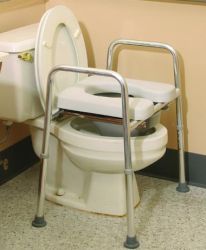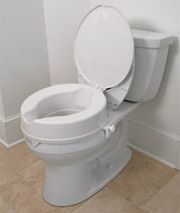Some things in life can be taken for granted until a disabling condition like a fracture, stroke or arthritis occurs. When independence in the bathroom is lost, embarrassment and depression can occur. That’s why it’s great that there is numerous toilet assistive devices and toilet equipment to help get off the toilet. These devices help individuals maintain their independence and dignity in the bathroom.
The use of assistance devices in the wake of debilitating injuries and disease improves the quality of life greatly and the cost is negligible compared to the cost of hospital beds or motorized mobility wheelchairs. Maintenance costs beyond ordinary cleaning are usually nonexistent too. Certain standards for such assistive devices are set by the government in accordance with the American with Disabilities Act.
Toilet Assistance
Toilet Safety Rails
 Several types of toilet assistive devices exist. Among the simplest aids are toilet rails that can be mounted to the wall or toilet. These toilet rails can be mounted on the standard toilet and allow for support when sitting or standing.
Several types of toilet assistive devices exist. Among the simplest aids are toilet rails that can be mounted to the wall or toilet. These toilet rails can be mounted on the standard toilet and allow for support when sitting or standing.
Vertical Poles
If these wall or toilet mounts is not an option, there is a variation of the grab bar that works like a vertical pole and can be attached from the ceiling to the floor. Other devices include the high rise toilet and raised toilet seat.
Raised Toilet Seats
If you do not need the extra support on the sides, there are easy to install raised toilet seats that provide an extra 2-6 inches of height. The raised toilet seat helps assist individuals who have trouble bending and standing up by raising the height of the toilet seat. They make it easier to sit down as well. Anyone having hip or knee problems will find the extra height a necessity rather than a luxury. There will be less straining during the process as well.

Some raised toilet seats are elongated while others have grab bars to help steady the individual. They are usually made of plastic or vinyl and some lock in place while other are just placed on the commode without any locking system. Some assistive devices have both a frame and a rail and can fit over the commode or be free standing. Of course, there are common devices like the urinal and bedside commodes that reduce trips to the bathroom and can be a great help to individuals with mobility problems.
Whether the problem is pain, stiffness, weakness, imbalance or partial paralysis, toilet assistive devices like toilet rails and raised toilet seats can relieve stress and work great as assistive equipment to help get off the toilet. Keep your independence in the bathroom!
